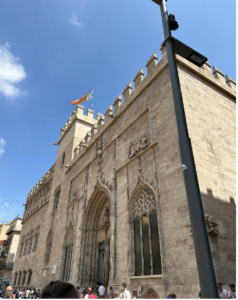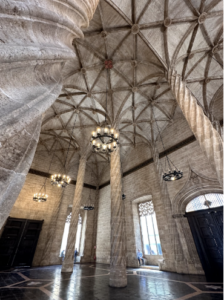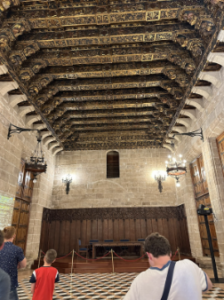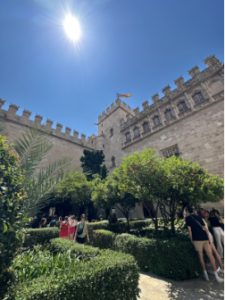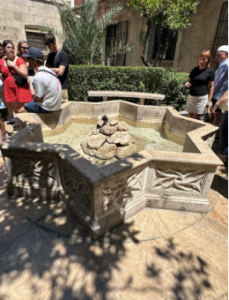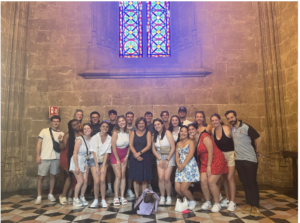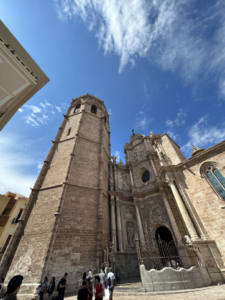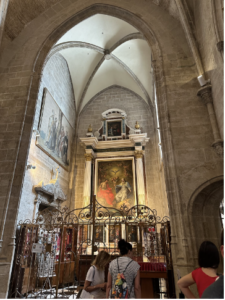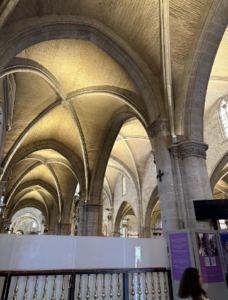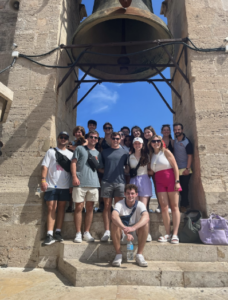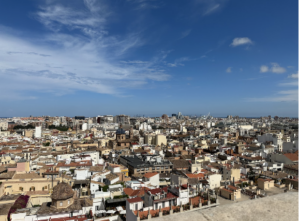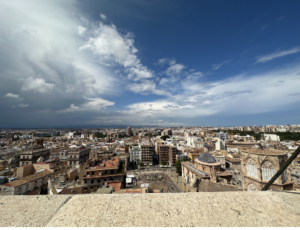Written by: Ailish Dixon (Session 1)
Today our Maymester group went to take Flamenco lessons in Madrid! A few days ago we went to see a Flamenco performance in a cave in Granada and the experience was incredible. We were right up close to the performers so we could really see every slight movement and facial expression of the dancers. We could really feel the music and
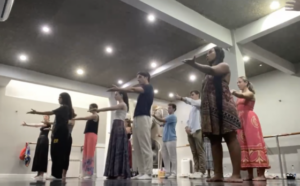 movement as it enveloped the room. The performance had such a huge impact on me and everyone in our group as we had never seen anyone dance with such skill, passion and emotion before. Although learning Flamenco ourselves for the first time was definitely not going to come out looking like the breathtaking performance we experienced in Granada, everyone was very excited to learn some Flamenco.
movement as it enveloped the room. The performance had such a huge impact on me and everyone in our group as we had never seen anyone dance with such skill, passion and emotion before. Although learning Flamenco ourselves for the first time was definitely not going to come out looking like the breathtaking performance we experienced in Granada, everyone was very excited to learn some Flamenco.
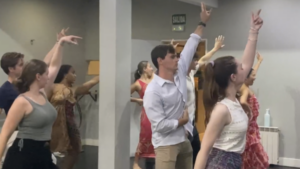
I am a dance minor at Holy Cross and have been dancing since I was little. Having a dance background was definitely very helpful in the class. However, Flamenco was very different from any style of dance I had ever learned before. I found that the
most difficult part of Flamenco for me was the difference in the tempo of the music and the shifting rhythms. Most of the music that I have danced to in the past is in basic 4/4 meter and is based on consistent counts of 8. The rhythm or beat in Flamenco is called the cómpas and dancers use palmas, which is clapping hands and stomping feet, to keep to the rhythm while dancing. The class started with us learning basic cómpas and the corresponding palmas. This compas served as the basis for the rhythm of the dance combination that the Flamenco instructor taught the group.
Before Flamenco class we spoke about Lorca and his explanation of the concept of duende in our class lecture. Duende is a feeling
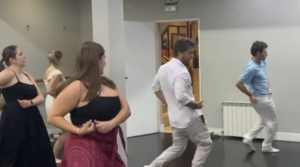
or self-expression that comes directly from one’s soul. Duende is expressed in the arts through passion, moving the audience and demonstrating an intense personal connection between the artist and their art. Although we only had an hour to learn some very basic flamenco steps, the class and the performance we experienced gave me a glimpse into the meaning of duende in Flamenco dance. From the short Flamenco combination, I discovered a contrast between movements exuding passion and movement that established strength or power. There was also a contrast between tension and release in the Flamenco choreography. Many of the movements required intense muscle control, making the movements very precise. Everyone had a lot of fun learning some basic Flamenco steps. I hope to get the chance to take another class and learn more Flamenco in the future!
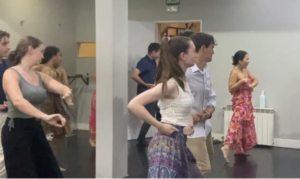


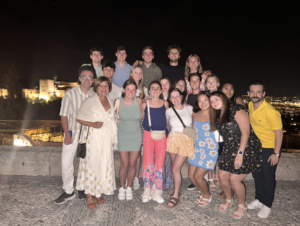
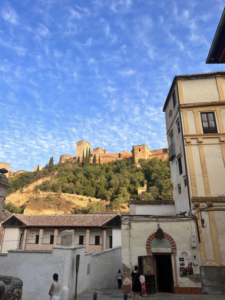
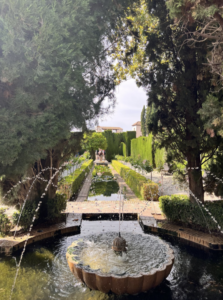
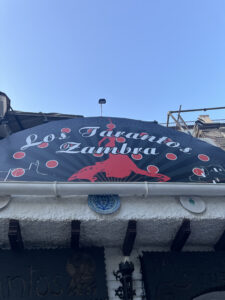 After several tiring yet thrilling days of traveling from Córdoba to Seville, we spent three exciting days in Granada, the second of which was one of my favorite days of this maymester so far.
After several tiring yet thrilling days of traveling from Córdoba to Seville, we spent three exciting days in Granada, the second of which was one of my favorite days of this maymester so far. 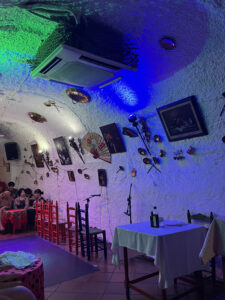
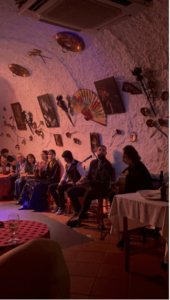
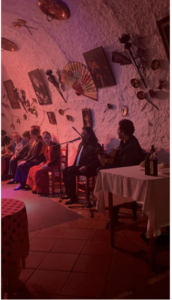
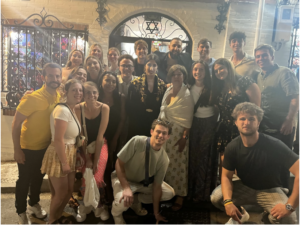
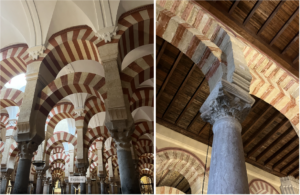
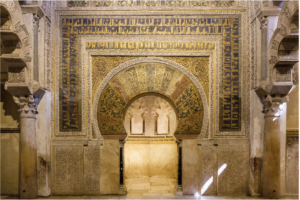
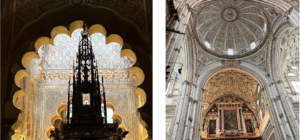
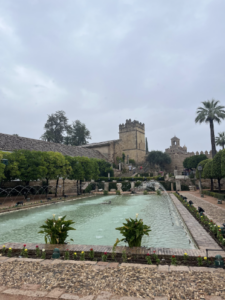 Una pregunta que tuve mientras viajamos por el sur de España – Córdoba, Sevilla, y Granada – fue si la Reconquista completamente borró a los musulmanes de la región. En nuestros viajes, vi como la religión y la cultura musulmana puede influir en una sociedad cristiana. Nuestro primer día en Córdoba, visitamos el Alcázar de los Reyes Cristianos, un lugar muy bonito y lleno de historia. Aquí, vi como aunque el espacio fue un espacio cristiano, todavía tenía influencia musulmana. Lo que es más obvio es el nombre. “Alcázar,” como aprendí, es una palabra árabe para un palacio real. Otra cosa que noté era la presencia de agua en los jardines en el Alcázar. Como los profesores me dijeron, los cristianos típicamente no se bañaban mucho. Por lo tanto, los musulamanes, cuando llegaron a España, introdujeron agua, y los reyes cristianos guardaron esta tradición y la adaptaron a su cultura. En nuestro segundo día, vimos patios cristianos que eran muy hermosos. Las flores eran brillantes; el agua brillaba con luz trémula. El olor de naranjas maduras colgaba en el aire. Aprendí que todos estos aspectos – los patios, la presencia de las flores y las frutas cítricas – son intrínsecamente musulmanes. Una vez más, vi cómo los cristianos adaptaron otra cultura en la suya.
Una pregunta que tuve mientras viajamos por el sur de España – Córdoba, Sevilla, y Granada – fue si la Reconquista completamente borró a los musulmanes de la región. En nuestros viajes, vi como la religión y la cultura musulmana puede influir en una sociedad cristiana. Nuestro primer día en Córdoba, visitamos el Alcázar de los Reyes Cristianos, un lugar muy bonito y lleno de historia. Aquí, vi como aunque el espacio fue un espacio cristiano, todavía tenía influencia musulmana. Lo que es más obvio es el nombre. “Alcázar,” como aprendí, es una palabra árabe para un palacio real. Otra cosa que noté era la presencia de agua en los jardines en el Alcázar. Como los profesores me dijeron, los cristianos típicamente no se bañaban mucho. Por lo tanto, los musulamanes, cuando llegaron a España, introdujeron agua, y los reyes cristianos guardaron esta tradición y la adaptaron a su cultura. En nuestro segundo día, vimos patios cristianos que eran muy hermosos. Las flores eran brillantes; el agua brillaba con luz trémula. El olor de naranjas maduras colgaba en el aire. Aprendí que todos estos aspectos – los patios, la presencia de las flores y las frutas cítricas – son intrínsecamente musulmanes. Una vez más, vi cómo los cristianos adaptaron otra cultura en la suya. 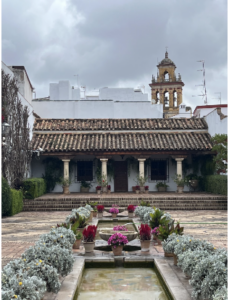 Otros lugares que tenían esta mezcla de culturas fueron la mezquita de Córdoba y la Alhambra en Granada. Ahora en día, la mezquita es una catedral, pero todavía hay elementos de la mezquita original. Por ejemplo, los arcos de rojo y blanco son un elemento musulmán. Hay espacios en la mezquita/la catedral donde los elementos de las dos casas de adoración se cruzan. Para mí, esto muestra cómo hay espacio para más de una religión o una cultura, y cómo todos podemos vivir juntos. Finalmente, quiero hablar un poco sobre la Alhambra, que está en Granada, la última ciudad que cayó a los cristianos durante la Reconquista. Una vez más, este lugar es una mezcla de las dos culturas. Un aspecto que fue interesante para mí es que las viñas son una característica musulmana.
Otros lugares que tenían esta mezcla de culturas fueron la mezquita de Córdoba y la Alhambra en Granada. Ahora en día, la mezquita es una catedral, pero todavía hay elementos de la mezquita original. Por ejemplo, los arcos de rojo y blanco son un elemento musulmán. Hay espacios en la mezquita/la catedral donde los elementos de las dos casas de adoración se cruzan. Para mí, esto muestra cómo hay espacio para más de una religión o una cultura, y cómo todos podemos vivir juntos. Finalmente, quiero hablar un poco sobre la Alhambra, que está en Granada, la última ciudad que cayó a los cristianos durante la Reconquista. Una vez más, este lugar es una mezcla de las dos culturas. Un aspecto que fue interesante para mí es que las viñas son una característica musulmana. 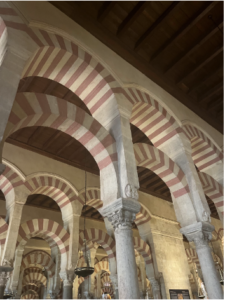
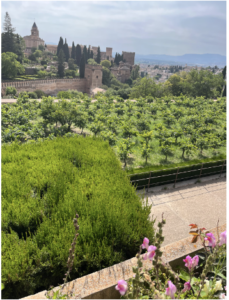 Para terminar mi blog, quiero regresar a mi primera cuestión:
Para terminar mi blog, quiero regresar a mi primera cuestión: 